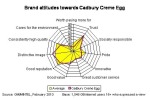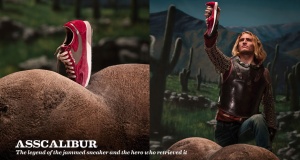Imagination
IKEA World without textiles
IKEA is promoting the launch of the 2012/2013 catalogue with an advertising campaign focusing on the new focus on textiles. “Imagine a world without textiles. A place where comfortable pillows are replaced with tree stumps. Where curtains are made of sheet metal, rugs are made of sand, and sofas are made of cactus. That’s a hard world. Literally. At IKEA, we have a soft spot for the soft parts. The fun and fluffy parts. The romantic and refreshing parts. The colorful and comfortable parts. The parts that put us to sleep, dry us off, help us relax and hide the stuff we don’t want to see. Without textiles, life is hard.
Outdoor ad geeks, here’s your latest bit of brilliance, courtesy of Ikea.
German ad agency Thjnk and production studio I Made This teamed up to create Ikea’s “RGB billboard,” which—much like Ikea furniture itself—makes the most of some very limited space.
The board features three different headlines superimposed on each other in different colors—cyan, magenta and yellow. At night, the board shines red, green and blue (RGB) lightbulbs on the board, revealing, in turn, the different headlines. Red bulbs illuminate the cyan text; green lights up magenta; and the blue-purple lights make yellow visible.
And that’s how you turn nine square meters of ad space into 27 square meters.
It’s a delightful little visual trick that embodies Ikea’s space-saving message. Now, if only it worked a little better during the day.
Color & Music
I have researched that: In 1982, Gerald J Gorn published an experiment showing that subjects were more likely to select a specific colour of pen if that pen had been paired with pleasant rather than unpleasant music. That means there is a strong relevant between Colour and Music. Typically, Colour and Music decisions are based on intuition and anecdotal evidence. As a platform, Colour and Music provide emotional and psychological senses running in advertising. Also, they are the point of mood controlling, which have a big impact on brand preference.
IKEA UK is promoting its range of role play toys and furniture for children in “Playing with my friends”, an integrated advertising campaign. Doll, Dinosaur, Action Figure, Monkey, Robot and Teddy Bear appear in a colorful trip around Ikea’s children’s kitchen, showing what hosting a dinner party looks like when the kids are in charge. The campaign includes a music video, television commercials and behind the scenes video, accompanied by UK band Masters in France. The “Playing with my friends” track is available as a single on iTunes.
IKEA has launched “Make more of your Garden”, an advertising campaign in the UK and Ireland using backyard gnomes to showcase the retailer’s outdoor living solutions and inspire people to transform their outdoor living spaces. The campaign, which features a 60 second TV ad and a 2 minute music video, brings together a couple who determinedly renovate their backyard despite the best efforts of pesky garden gnomes.
A couple tries to transform their garden with IKEA outdoor furniture, but they have some opposition to the change, from the ultimate embodiment of everything that’s tired and dreary about British gardens – the garden gnome. The gnomes will do anything possible to keep the garden the way that they like it, kitsch and dull. Every improvement the family makes, hanging colourful SOLVIN DEN solar-powered lights, erecting a KARLSÖ gazebo and introducing the ARHOLMA outdoor sofa, angers the gnomes, who do anything to stop the family.
The adverts, which launch on Saturday 13 April, look at a family trying to transform their garden with IKEA outdoor furniture, but they have some opposition to the change, from the ultimate embodiment of everything that’s tired and dreary about British gardens – the garden gnome. The gnomes will do anything possible to keep the garden the way that they like it – kitsch and dull. Every improvement the family makes, hanging colourful SOLVIN DEN solar-powered lights, erecting a KARLSÖ gazebo and introducing the ARHOLMA outdoor sofa, angers the gnomes, who do anything to stop the family.
The TV spot, features a cover version of the Mötley Crüe song ‘Time for Change’ by The Palace of Budapest Philharmonic Orchestra and The Heritage Singers. Five versions of the TV advert, directed by Mike Maguire at Biscuit, have been produced and include 60” 30” and 10” adverts that run until early June on TV as well as a full length music video running online at http://www.youtube.com/ikeauk. The campaign also features outdoor, press ads and online ads.
Peter Wright, IKEA UK and Ireland Marketing Manager, said, “With the third burst of our ongoing brand campaign it’s our ambition to continue the revitalisation and transformation of the IKEA brand in the UK and Ireland. Our goal is for the ‘Make more of your garden’ campaign to raise awareness of the wide range of outdoor solutions available in the IKEA store that can help them transform their outdoor space. It will demonstrate how easy and affordable it is to treat your outdoor spaces just like any other room in the home, ultimately encouraging consumers to choose IKEA for all of their outdoor home furnishing needs.”
Freddy Mandy, creative director at Mother, said: “To us, gnomes symbolize the lacklustre state of the nation’s gardens. They are tired, old fashioned and uninspired. So we imagined the gnomes’ reaction to a family installing new, exciting, modern garden furniture into their territory. It sparks a turf war, quite literally.”
Humor









